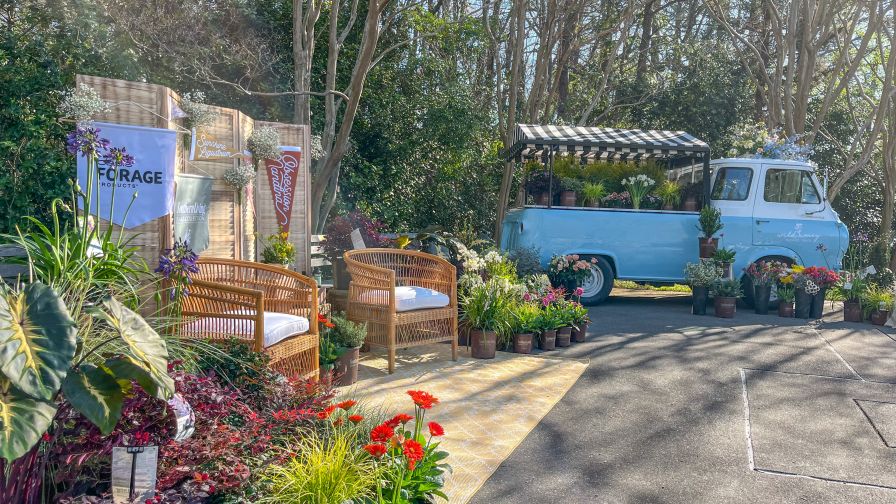Gerbera Central

Ed Van Wingerden and his son, Ivan, stem from a long line of Van Wingerden growers. Ivan is a senior at Cal Poly, and he has expressed interest in being a major player in the family business some day.
When the time came to choose a career, the choice had always come down to grower or priest for generations of Van Wingerden sons. So when Ed Van Wingerden’s father, John, told him he could pursue a career in any field, he found himself in a unique position along with his brothers, sisters and cousins.
“We have lots of growers and few priests in the family,” Ed Van Wingerden says. “We come from small towns, and I am part of the first generation that got to choose.”
Van Wingerden still chose grower, though, and the decision has clearly paid off. Twelve years after his father and three uncles founded Dutch Brothers, he branched off and founded Ever-Bloom in Carpinteria, Calif. Originally, he bought 18-plus acres behind the Dutch Brothers, built the first four acres of greenhouses four years later and began to grow mainly gerberas after that particular market showed great promise in the late-1970s.
Today, Ever-Bloom is recognized as one of the largest gerbera growers in the United States, establishing a niche as a grower-shipper that offers about 275 retail-ready varieties with an assortment of packaging options for the wholesale operations it serves. Keep in mind, Ever-Bloom only serves wholesalers.
“We are a niche because we don’t compete on the same level as others on price and quantity,” Van Wingerden says. “Wholesalers call us because they know when they order a certain color, they’re not going to receive something that’s kind of like that color or the wrong color. They’re going to get the quantity they ordered, the color they ordered and it’s going to be packaged the most efficiently. We’ve been doing this for years.”
Good-Looking Gerberas
Two separating factors between Ever-Bloom and average gerbera growers across the world are packaging and shipping. Ever-Bloom probably offers the most expensive gerberas on the market, Van Wingerden says, but the company’s standing-order prices are worth the extra money because Ever-Bloom packages more effectively and ships more efficiently than others. Its focus is more toward the higher-end customer anyway, and packaging and shipping are qualities at the top of its customers’ lists.
“We have to look at the wholesaler and how they want to move the product to the retailer,” he says. “Usually, that means we have to provide smaller packages. Retailers don’t buy huge volumes, so the more accurately we can pack gerberas in a single unit, the better off everybody is.”
Gerb-Pacs are Ever-Bloom’s solution to any packaging dilemmas it previously had. Gerberas can be packaged in dry packs, which allow growers to ship more flowers per cubic foot and showcase flowers more pleasantly. The dilemma, however, is keeping gerberas hydrated. And what about wet packs? They certainly solve hydration problems, but packages can potentially get messy–and they aren’t as appealing to wholesalers and the end retailer when presented that way.
Clean packages following hours or days of shipping is obviously important, and Ever-Bloom’s Gerb-Pac packaging keeps flowers well hydrated with the least possible water to alleviate handling and weight concerns. Flowers are arranged in rows by color, and packages are easy to handle once received on the wholesale or retail end.
“You get the best of both worlds,” Van Wingerden says. “Nice presentation and the advantage that flowers are in water. You have to be willing to do more for less and operate very efficiently to survive. You beat your competitor by giving more service and not cutting back on things that compromise quality. When times get tough, the first growers to go will be the ones who don’t concentrate on quality. Yes, it costs money to provide a quality product, but we don’t throw in the towel, for example, just because the cost of energy is high.”
OK, so Ever-Bloom has presentation covered. What about shipping? Ever-Bloom has access to a typical fleet of trucks that deliver across the U.S., and it also relies on air travel for many of its deliveries.
“We do an enormous amount of FedEx shipping,” he says. “Customers call us at, say, 10 o’clock, tell us what they need and they have it 24 hours later. If it doesn’t get there at 10 o’clock, it’s freight free. It is surprising, even as expensive as freight is, how many people wait until the last minute and need orders the next day.”
In recent years, Ever-Bloom also installed a smart cooler that encompasses 2,800 square feet to ensure gerberas are pre-cooled to the right temperature. The cooler is equipped with state-of-the-art technological features, including sensors that can gauge how many flowers are stored inside. The temperature of the cooler can then be altered accordingly.
Although Ever-Bloom is a large growing operation, it isn’t the only one that specializes in gerberas. Many rose growers have shifted to gerberas in recent years, and more gerberas are being shipped to the U.S. from South American countries. Van Wingerden doesn’t feel any pressure from South American growers, though.
“Fortunately, between the packaging you must have for gerbera and the freight, it is still not that interesting to get gerbera from South America,” he says. “I find we have less competition than other growers because of our niche.”
Ahead Of The Curve
Ever-Bloom might have less competition, but it still encounters many of the same challenges all growers do. Energy costs, for example, have taken their toll on Ever-Bloom, but the company has a sophisticated shade system in place and uses an energy curtain during the day to capture extra humidity.
“We found that gerbera like a little bit more humidity during the day,” says Van Wingerden, who reports a 39 percent savings in energy despite a $60,000 increase in energy expenditure over recent years. “Hot weather will actually close that humidity curtain. It has very little shade in it, so we were able to maintain a higher humidity underneath where we needed it by the crop. At night, especially in the winter, we can close both of those curtains.”
Labor is another challenge facing Ever-Bloom, whose head grower is Roberto Vega. California could really use a guest worker program or a more relaxed form of immigration control, Van Wingerden says, considering events that have transpired in other states. He’s seen states crack down on companies for hiring workers with illegal Social Security numbers, and that’s particularly alarming to him.
“That’s tough for us, because we get Social Security cards and documents that sure look official,” he says. “We take copies of it, file everything and if California is going to implement immigration control, agriculture and service industries are going to be in serious trouble. I think the reason we haven’t seen it yet is because there is no easy answer here.”
There’s no easy way to lure workers to Carpinteria for minimum wage salaries, either. Typical homes run close to $1 million, but Ever-Bloom provides affordable housing for about half of its 50-person crew.
“We always joke that we grow in a resort,” Van Wingerden says. “The standards of living here are enormous. It’s like living in Camelot, but we kind of have a natural air conditioner in the Pacific Ocean that makes our spot a great one for growing.”
Ever-Bloom’s location is indeed ideal near the mountains, but it is ideal for thrips, too. Thrips is probably the operation’s biggest nemesis, and Ever-Bloom launched a biological pest control program years ago to combat it and other pests that affect business. Ever-Bloom might occasionally fall back on more traditional chemicals, but the continuous introduction of predacious insects into the greenhouse has been mostly effective, Van Wingerden says.
“We’ve come a long ways with it and fortunately, chemical companies have jumped on the bandwagon making the soft chemicals and pest-specific items we need. We’re seeing phenomena we never saw before. When you have a biological control system in place, you do find that you run into other insects. Then, you have to find the next predacious insect or a soft chemical that works.”
Ever-Bloom has also had success recirculating its water, and it even earned a water quality award a few years ago from the Central Coast Regional Water Quality Control Board in California. In the summer, Ever-Bloom recaptures as much as 50,000 gallons of water each day through a closed-loop system. Water recirculation has resulted in savings, too, and Van Wingerden will take them where he can find them.
“Times are tough,” he says. “We have to do a lot more for a lot less. Margins have gotten slim, but those who hang in there and wait it out will see better times.”








